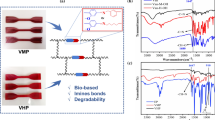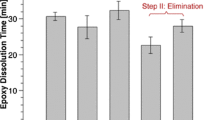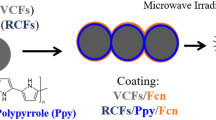Abstract
Carbon fiber thermoset composites pose significant challenges due to their inability to be reprocessed and the difficulties in recycling carbon fibers. Vitrimer materials with reversible dynamic covalent bonding offer a promising solution for the degradation of thermosetting resins and the recycling of carbon fibers. However, their practical application is limited by inability to quickly release stresses from deformation and long degradation times. To address these limitations, this study presents a novel vitrimer material based on free amine-catalyzed aromatic dynamic disulfide exchange. The dynamic disulfide exchange network, catalyzed by free amines, exhibits rapid stress relaxation, with a relaxation time of only 14 s at 180 °C. This exceptional dynamic exchange capability grants the vitrimer material outstanding self-healing properties, shape memory functionality, and recycling performance. Moreover, the higher concentration of disulfide bonds and the generation of small molecules increase the susceptibility of the crosslinked network to thiol degradation, resulting in resin degradation within 5 h. Additionally, this research successfully applies the vitrimer material as a matrix to prepare carbon fiber composites with exceptional mechanical properties. Furthermore, by degrading the resin matrix, effective recycling of carbon fibers is achieved, contributing to sustainable practices in the automotive and aerospace industries.







Similar content being viewed by others
Data availability
Data for the study is available upon reasonable request from the corresponding author.
References
Tamez MBA, Taha I (2021) A review of additive manufacturing technologies and markets for thermosetting resins and their potential for carbon fiber integration. Addit Manuf 37:101748
Wang Q, Ning H, Vaidya U, Pillay S, Nolen L-A (2015) Development of a carbonization-in-nitrogen method for measuring the fiber content of carbon fiber reinforced thermoset composites. Compos Part a-Appl S 73:80–84
Ziaee M, Johnson JW, Yourdkhani M (2022) 3D Printing of Short-Carbon-Fiber-Reinforced Thermoset Polymer composites via Frontal polymerization. ACS Appl Mater Inter 14:16694–16702
Feng P, Ma L, Wu G, Li X, Zhao M, Shi L, Wang M, Wang X, Song G (2020) Establishment of multistage gradient modulus intermediate layer between fiber and matrix via designing double ‘rigid-flexible’ structure to improve interfacial and mechanical properties of carbon fiber/resin composites. Compos Sci Technol 10:200
Feng PF, Song GJ, Li XR, Xu H, Xu LY, Lv DD, Zhu X, Huang YD, Ma LC (2021) Effects of different rigid-flexible structures of carbon fibers surface on the interfacial microstructure and mechanical properties of carbon fiber/epoxy resin composites. J Colloid Interf Sci 583:13–23
Sarkari-Oskuei E, Safavi-Mirmahalleh S-A, Sofla RLM, Roghani-Mamaqani H, Salami-Kalajahi M (2023) Synthesis of recyclable polyurethane-based pseudo-vitrimer: comparison of properties with conventional polyurethane. J Polym Res 30:338
Lagel MC, Pizzi A, Basso MC, Abdalla S (2015) Development and characterization of abrasive grinding wheels with a tannin-furanic resins matrix. Ind Crop Prod 65:343–348
Sonnenfeld C, Mendil-Jakani H, Agogue R, Nunez P, Beauchene P (2017) Thermoplastic/thermoset multilayer composites: a way improve the impact damage tolerance of thermosetting resin matrix to composites. Compos Struct 171:298–305
Adekunle K, Cho SW, Ketzscher R, Skrifvars M (2012) Mechanical properties of natural fiber hybrid composites based on renewable thermoset resins derived from soybean oil, for use in technical applications. J Appl Polym Sci 124:4530–4541
Barré S, Chotard T (1996) Benzeggagh, comparative study of strain rate effects on mechanical properties of glass fibre-reinforced thermoset matrix composite. Compos Part A-Appl S 27:1169–1181
Lucherelli MA, Duval A, Averous L (2022) Biobased vitrimers: towards sustainable and adaptable performing polymer materials. Prog Polym Sci 127:101515
Liu X, Zhang E, Feng Z, Liu J, Chen B, Liang L (2021) Degradable bio-based epoxy vitrimers based on imine chemistry and their application in recyclable carbon fiber composites. J Mater Sci 56:15733–15751
Li M, Zhao G, Liu X, Xie X, Zhang C, Yu H, Jian X, Song Y, Xu J (2023) Self-healing interface of carbon fiber reinforced composites based on reversible hydrogen-bonded interactions. Compos Commun 40:101631
Cheng C, Li J, Yang F, Li Y, Hu Z, Wang J (2018) Renewable eugenol-based functional polymers with self-healing and high temperature resistance properties. J Polym Res 25:57
Zhang W, Zhou Q, Fang C, You L, Li X, Liu M, Dong X, Qi Y, Wang B, Li W (2022) Dynamic networks for polyimine with disulfide bond to obtain catalyst-free recyclability, multi-degradation and malleability. J Polym Res 29:154
Krishnakumar B, Sanka RVSP, Binder WH, Parthasarthy V, Rana S, Karak N (2020) Vitrimers: associative dynamic covalent adaptive networks in thermoset polymers. Chem Eng J 385:123820
Montarnal D, Capelot M, Tournilhac F, Leibler L (2011) Silica-like Malleable materials from Permanent Organic Networks. Science 334:965–968
Liu T, Zhao B, Zhang J (2020) Recent development of repairable, malleable and recyclable thermosetting polymers through dynamic transesterification. Polymer 194:122392
Xu Y, Dai S, Bi L, Jiang J, Zhang H, Chen Y (2022) Catalyst-free self-healing bio-based vitrimer for a recyclable, reprocessable, and self-adhered carbon fiber reinforced composite. Chem Eng J 429:132518
Xu Y, Zhang H, Dai S, Xu S, Wang J, Bi L, Jiang J, Chen Y (2022) Hyperbranched polyester catalyzed self-healing bio-based vitrimer for closed-loop recyclable carbon fiber-reinforced polymers. Compos Sci Technol 228:109676
Hendriks B, Waelkens J, Winne JM, Du FE, Prez (2017) Poly(thioether) Vitrimers via Transalkylation of Trialkylsulfonium salts, ACS Macro. Lett 6:930–934
Huang J, Zhang L, Tang Z, Wu S, Guo B (2018) Reprocessable and robust crosslinked elastomers via interfacial C-N transalkylation of pyridinium. Compos Sci Technol 168:320–326
Liu Y-Y, He J, Li Y-D, Zhao X-L, Zeng J-B (2020) Biobased, reprocessable and weldable epoxy vitrimers from epoxidized soybean oil. Ind Crop Prod 153:112576
Si H, Zhou L, Wu Y, Song L, Kang M, Zhao X, Chen M (2020) Rapidly reprocessable, degradable epoxy vitrimer and recyclable carbon fiber reinforced thermoset composites relied on high contents of exchangeable aromatic disulfide crosslinks. Compos Pt B-Eng 19:108278
Chen M, Wu Y, Chen B, Tucker AM, Jagota A, Yang S (2022) Fast, strong, and reversible adhesives with dynamic covalent bonds for potential use in wound dressing. P Natl Acad Sci USA 119:e2203074119
Shi YM, Hong YG, Hong JY, Yu AY, Lee MW, Lee JY, Goh M (2022) Bio-based boronic ester vitrimer for realizing sustainable and highly thermally conducting nanocomposites. Compos Pt B-Eng 244:110181
Lu Y-X, Tournilhac F, Leibler L, Guan Z (2012) Making Insoluble Polymer Networks Malleable via Olefin Metathesis. J Am Chem Soc 134:8424–8427
Wang YQ, Cui XJ, Yang QQ, Deng TS, Wang YX, Yang YX, Jia SY, Qin ZF, Hou XL (2015) Chemical recycling of unsaturated polyester resin and its composites via selective cleavage of the ester bond. Green Chem 17:4527–4532
Xu Y, Ma H, Zhang H, Xu S, Cheng X, Bi L, Jiang J, Chen Y (2023) A dual dynamic network self-healing bio-based vitrimer and its application in multiply recyclable carbon fiber reinforced polymers. Ind Crop Prod 198:116755
Liu Y-Y, Liu G-L, Li Y-D, Weng Y, Zeng J-B (2021) Biobased High-Performance Epoxy Vitrimer with UV shielding for recyclable Carbon Fiber Reinforced composites, ACS sustainable. Chem Eng 9:4638–4647
An X, Ding Y, Xu Y, Zhu J, Wei C, Pan X (2022) Epoxy resin with exchangeable diselenide crosslinks to obtain reprocessable, repairable and recyclable fiber-reinforced thermoset composites. React Funct Polym 172:105189
Zhou F, Guo Z, Wang W, Lei X, Zhang B, Zhang H, Zhang Q (2018) Preparation of self-healing, recyclable epoxy resins and low-electrical resistance composites based on double-disulfide bond exchange. Compos Sci Technol 167:79–85
Krishnakumar B, Sanka RVSP, Binder WH, Park C, Jung J, Parthasarthy V, Rana S, Yun GJ (2020) Catalyst free self-healable vitrimer/graphene oxide nanocomposites. Compos Pt B-Eng 184:107647
Tang S, Lin H, Dong K, Zhang J, Zhao C (2023) Closed-loop recycling and degradation of guaiacol-based epoxy resin and its carbon fiber reinforced composites with S-S exchangeable bonds. Polym Degrad Stabil 210:110298
de Luzuriaga AR, Martin R, Markaide N, Rekondo A, Cabanero G, Rodriguez J, Odriozola I (2016) Epoxy resin with exchangeable disulfide crosslinks to obtain reprocessable, repairable and recyclable fiber-reinforced thermoset composites. Mater Horiz 3:241–247
Toldy A, Pomazi A, Szolnoki B (2020) The effect of manufacturing technologies on the flame retardancy of carbon fibre reinforced epoxy resin composites. Polym Degrad Stabil 174:109094
Hammami A, Gebart BR (2010) Analysis of the vacuum infusion molding process. Polym Compos 21:28–40
Matxain JM, Asua JM, Ruiperez F (2016) Design of new disulfide-based organic compounds for the improvement of self-healing materials. Phys Chem Chem Phys 18:1758–1770
de Rekondo AR, Solera G, Azcarate-Ascasua I, Boucher V, Grande HJ, Rekondo A (2022) Chemical control of the aromatic disulfide exchange kinetics for tailor-made epoxy vitrimers. Polymer 239:124457
Nevejans S, Ballard N, Miranda JI, Reck B, Asua JM (2016) The underlying mechanisms for self-healing of poly(disulfide)s. Phys Chem Chem Phys 18:27577–27583
Ji FC, Liu XD, Sheng DK, Yang YM (2020) Epoxy-vitrimer composites based on exchangeable aromatic disulfide bonds: reprocessibility, adhesive, multi-shape memory effect. Polymer 197:122514
Zhou Q, Zhu XJ, Zhang WH, Song N, Ni LZ (2020) Recyclable high performance epoxy composites based on double dynamic Carbon-Nitrogen and Disulfide Bonds. ACS Appl Polym Mater 2:1865–1873
Chen J-H, An X-P, Li Y-D, Wang M, Zeng J-B (2018) Reprocessible Epoxy Networks with Tunable Physical properties: synthesis, stress relaxation and recyclability. Chin J Polym Sci 36:641–648
El-Zaatari BM, Ishibashi JSA, Kalow JA (2020) Cross-linker control of vitrimer flow. Polym Chem-UK 11:5339–5345
Deng H, Ye J, Zu Z, Lin Z, Huang H, Zhang L, Ye X, Xiang H (2023) Repairable, reprocessable and recyclable rigid silicone material enabled by dual dynamic covalent bonds crosslinking side-chain. Chem Eng J 465:143038
Rong J, Zhong J, Yan W, Liu M, Zhang Y, Qiao Y, Fu C, Gao F, Shen L, He H (2021) Study on waterborne self-healing polyurethane with dual dynamic units of quadruple hydrogen bonding and disulfide bonds. Polymer 221:123625
Takahashi A, Ohishi T, Goseki R, Otsuka H (2016) Degradable epoxy resins prepared from diepoxide monomer with dynamic covalent disulfide linkage. Polymer 82:319–326
Acknowledgements
This work was supported by the National Natural Science Foundation of China [grant number 52075526], the “Ningbo 3315 Plan Innovation Team” [grant number 2017A-28-C], the National Natural Science Foundation of China [grant number 91860204], the Fundamental Research Funds for the Central Universities [grant number DUT22-LAB605], the National Key Research and Development Program [grant number 2018YFB1107500], and the financial support from National Young Talents Program of China.
Funding
National Natural Science Foundation of China, 52075526, Jian Xu, 91860204, Xigao Jian, Ningbo 3315 Plan Innovation Team, 2017A-28-C, Jian Xu, Fundamental Research Funds for the Central Universities, DUT22-LAB605, Xigao Jian, National Key Research and Development Program, 2018YFB1107500, Jian Xu.
Author information
Authors and Affiliations
Contributions
Qinghua Zhang: Conceptualization, Methodology, Investigation, Formal analysis, Data curation, Visualization, Writing—Original draft preparation, Writing – Review & Editing. Mingzhuan Li: Visualization, Investigation. Peifeng Feng: Investigation, Methodology. Luoli Meng: Investigation, Methodology. Xigao Jian: Funding Acquisition, Supervision. Jian Xu (Corresponding Author): Conceptualization, Methodology, Funding Acquisition, Resources, Supervision, Writing—Review & Editing.
Corresponding author
Ethics declarations
Conflict of interest
The authors declare that they have no conflict of interest.
Additional information
Publisher's Note
Springer Nature remains neutral with regard to jurisdictional claims in published maps and institutional affiliations.
Supplementary Information
Below is the link to the electronic supplementary material.
Rights and permissions
Springer Nature or its licensor (e.g. a society or other partner) holds exclusive rights to this article under a publishing agreement with the author(s) or other rightsholder(s); author self-archiving of the accepted manuscript version of this article is solely governed by the terms of such publishing agreement and applicable law.
About this article
Cite this article
Zhang, Q., Li, M., Feng, P. et al. Rapid stress relaxation and degradable aromatic disulfide vitrimer for recyclable carbon fiber reinforced composite. J Polym Res 31, 87 (2024). https://doi.org/10.1007/s10965-024-03939-z
Received:
Accepted:
Published:
DOI: https://doi.org/10.1007/s10965-024-03939-z




